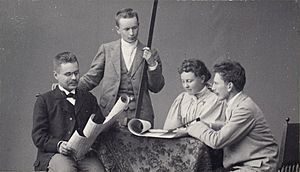Eliel Saarinen facts for kids
Quick facts for kids
Eliel Saarinen
|
|
|---|---|
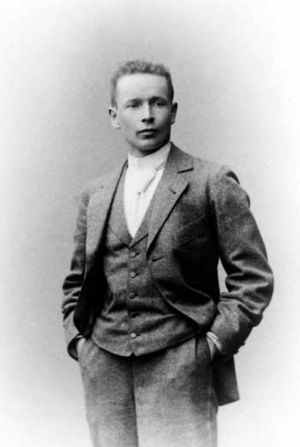
Eliel Saarinen in early 1900s
|
|
| Born |
Gottlieb Eliel Saarinen
August 20, 1873 |
| Died | July 1, 1950 (aged 76) |
| Nationality | Finnish |
| Occupation | Architect |
| Spouse(s) | Loja Saarinen |
| Children |
|
| Awards | AIA Gold Medal |
| Buildings |
|
| Projects |
|
| Design |
|
Gottlieb Eliel Saarinen (born August 20, 1873 – died July 1, 1950) was a famous Finnish-American architect. He was known for designing buildings in the Art Nouveau style. This style used natural shapes and curves. Eliel Saarinen was also the father of another well-known architect, Eero Saarinen.
Contents
Life and Work in Finland
Eliel Saarinen studied architecture in Helsinki, Finland. From 1896 to 1905, he worked with two partners, Herman Gesellius and Armas Lindgren. Their company was called Gesellius, Lindgren, Saarinen.
His first big project with the firm was the Finnish building at the Paris World Fair in 1900. This building showed a mix of styles. It included ideas from Finnish wooden buildings, British Gothic Revival, and a German art style called Jugendstil.
Saarinen's early work became known as the Finnish National Romantic Style. A great example of this style is the Helsinki Central railway station. He designed it in 1904, and it was built between 1910 and 1914.
City Planning and Designs
From 1910 to 1915, Saarinen worked on a large city-planning project for Munksnäs-Haga. He even wrote a book about it. In 1911, he became a city planning expert for Tallinn, Estonia. He was also asked to help with city development in Budapest, Hungary.
In 1912, Saarinen entered a global competition to design the new capital city of Canberra in Australia. He came in second place. The next year, he won first place in a competition for his plan of Reval (now Tallinn). From 1917 to 1918, he worked on a city plan for a larger Helsinki. He also designed postage stamps in 1917 and the Finnish markka banknotes in 1922.
Family Life
Eliel Saarinen married his second wife, Louise (Loja) Gesellius, in 1904. Loja was a sculptor and the younger sister of his business partner, Herman Gesellius. They had a daughter named Eva-Lisa (Pipsan) in 1905. Their son, Eero, who also became a famous architect, was born in 1910.
Move to the United States
In 1923, Eliel Saarinen moved to the United States. This happened after his design for the Tribune Tower in Chicago won second place in a competition. Even though his design was not built, its modern look inspired many other skyscrapers. Saarinen first lived in Evanston, Illinois. There, he worked on a plan for the Chicago lakefront. In 1924, he became a visiting professor at the University of Michigan.
Cranbrook Educational Community
In 1925, a man named George Gough Booth asked Saarinen to design the campus for the Cranbrook Educational Community. Booth wanted Cranbrook to be like the famous Bauhaus art school in America. Saarinen taught there and became the president of the Cranbrook Academy of Art in 1932. Some of his students, like Ray Eames and Charles Eames, were influenced by him. They later became famous for their furniture designs.
Other Designs and Influence
From 1929 to 1934, Saarinen designed products for a company called Wilcox Silver Plate Co. One of his most famous designs was a tea urn from around 1934. This tea urn has been shown in many art museums around the world.
Eliel Saarinen also became a professor in the Architecture Department at the University of Michigan. His son, Eero, became one of the most important American architects of the mid-20th century. Eero was a leader in the International style of architecture. One of Eliel's students, Edmund N. Bacon, became very well known for his work in city planning in Philadelphia.
Eliel Saarinen received the AIA Gold Medal in 1947. This is a very high award for architects in America.
Significant Works
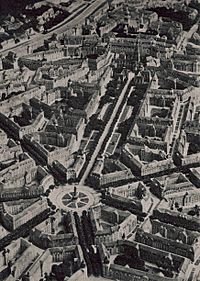
| Work | Location | Finished | Picture |
|---|---|---|---|
| Finnish Pavilion at the Exposition Universelle (designed with Herman Gesellius and Armas Lindgren) |
Paris | 1900 | 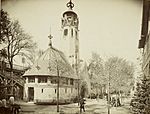 |
| Hvitträsk | Kirkkonummi | 1902 |  |
| National Museum of Finland | Helsinki | 1904 | 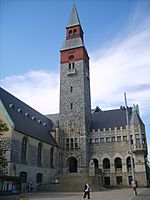 |
| Luther Factory Workers' Canteen and People's House (designed with Herman Gesellius and Armas Lindgren) |
Tallinn | 1905 | 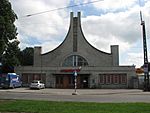 |
| Helsinki Central railway station | Helsinki | 1909 | 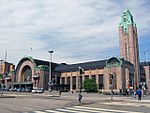 |
| Lahti Town Hall | Lahti | 1911 |  |
| Former Credit Bank Headquarters ("Saarinen House") | Tallinn | 1912 | 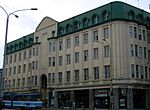 |
| Vyborg railway station | Vyborg | 1913 | 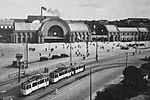 |
| Joensuu Town Hall | Joensuu | 1914 | 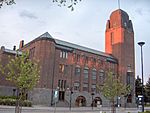 |
| Saint Paul's Church | Tartu | 1917 | 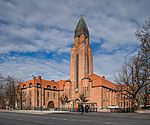 |
| Marble Palace | Helsinki | 1918 | 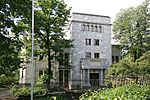 |
| Munkkiniemi Pension house | Helsinki | 1920 |  |
| Koussevitzky Music Shed | Lenox | 1938 |  |
| Kleinhans Music Hall | Buffalo | 1940 |  |
| Crow Island School | Winnetka | 1940–41 | 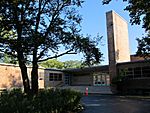 |
| First Christian Church | Columbus, IN | 1942 | 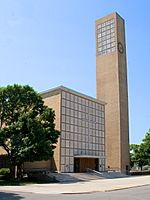 |
| Cranbrook Educational Community | Bloomfield Hills | 1940s | 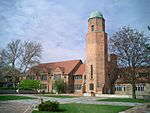 |
| Des Moines Art Center | Des Moines | 1948 |  |
| Christ Church Lutheran | Minneapolis | 1949 |  |
See also
 In Spanish: Eliel Saarinen para niños
In Spanish: Eliel Saarinen para niños
- Eliel Square
- Saarinen Tower


